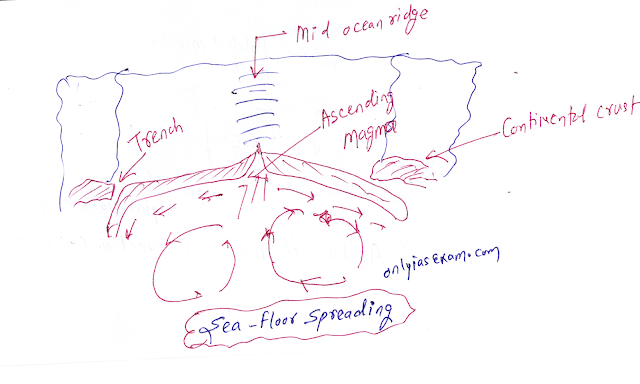Question:
Write explanatory notes on Sea floor spreading. ( UPPSC 1998)
Answer.
In the 1940s, based on the study of the topography of the ocean floor, especially the bottom of the Atlantic Ocean, the following facts emerged:
- Volcanic eruptions are common near all mid-oceanic ridges, and these areas have new crustal deposits of large amounts of lava.
- There are remarkable similarities in terms of the period of formation of equidistant rocks, chemical composition, and magnetic properties on either side of the summit of the mid-oceanic ridge. The age of rocks increases as we move away from the mid-oceanic ridge. The oldest sea rock is found near the trenches.
- The age of the ocean floor is less than 200 million years while the age of the continents is about 3200 million years.
- The sedimentary deposits of the ocean floor are very thin and the sediment column is not older than 200 million years.
- Ocean earthquakes that occur near the mid-oceanic ridge have their center of origin found at a low depth.
The seafloor spreading theory explains the reason for the occurrence of the above facts. H. Hess was the first to elaborate on the above facts in 1961, widely known as the "seafloor spreading" hypothesis. A number of facts were later added to the hypothesis and it is currently known as the seafloor spreading theory.
As per seafloor spreading theory:

- Convection current brings heat from the core and lower mantle to the lithosphere. Convection currents are the driving force of the movement of tectonic plates (lithospheric plates).
- The spread of the ocean floor occurs in divergent convection currents( or plate boundaries).
- Near the mid-oceanic ridge, the land moves away from both sides and magma rises up to fill the gap, and then cools to form a new oceanic crust.
- New oceanic crust is formed at the mid-oceanic ridge and it sinks into the asthenosphere in the trench.
- The ocean floor moves from the mid-oceanic ridge to the trench and they act as a conveyor belt.

Evidence of seafloor spreading theory:
- The younger age of the oceanic floor( less than 200 million years) is evidence of seafloor spreading.
- Rocks' age increase when one goes away from the oceanic ridge proves it the sea spreading theory.
You may like also:


ConversionConversion EmoticonEmoticon